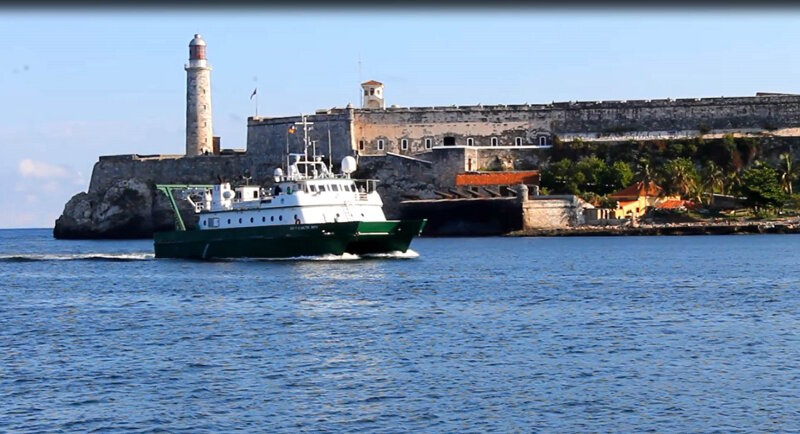
By John Reed, Research Professor & Chief Scientist - Harbor Branch Oceanographic Institute at Florida Atlantic University
May 17, 2017

The R/V Walton Smith arriving in the port of Havana, 8 a.m., May 16, 2017. Image courtesy of Centro Nacional de Áreas Protegidas, Cuba’s Twilight Zone Reefs and Their Regional Connectivity. Download high resolution image (jpg, 343 KB).
At 4 a.m., May 16, and 30 hours after casting off Miami, I awake as I hear the engines slow. I look out my cabin port hole to see a glimmering sea in the moonlight and in the distance, the high rises of Havana.
At 8:00 a.m., the pilot guides us into the port of Havana. Later in the day, the Cuban scientists participating in Leg 1 came on board.
After our greetings and safety briefing by the captain, we reviewed our science plans and proposed dive sites.
We primarily selected dive sites located within or off marine protected areas and national marine sanctuaries such as Guanahacabibes and off known shallow water reef sites that the Cuban scientists had been monitoring for years.
In Cuba, 25 percent of their coastal marine habitat is designated as marine protected areas. Most of the Cuban scientists that came on board are actively working and studying these areas. On Leg 1 of the cruise, we have scientists studying corals, sponges, algae, fish, and oceanography.
Around 1 p.m. the following day, we headed out to sea to our first dive site about 20 miles away.
As we passed the sea buoy, we were met with more than a fresh breeze, but rather a brisk 20-knot wind and five to six-foot seas. We went ahead and prepped the remotely operated vehicle (ROV) for the planned dive to 150-meters depth and set up our science stations to record the ROV video/photo data.
But as we got on site, we realized that it was not to be today. Just too rough and windy to launch the ROV. Oh well, this has happened many a time in my 42-year career as a marine biologist – nature always trumps! This evening we are now steaming to our next dive site, 50 miles west, and hopefully out of the wind.